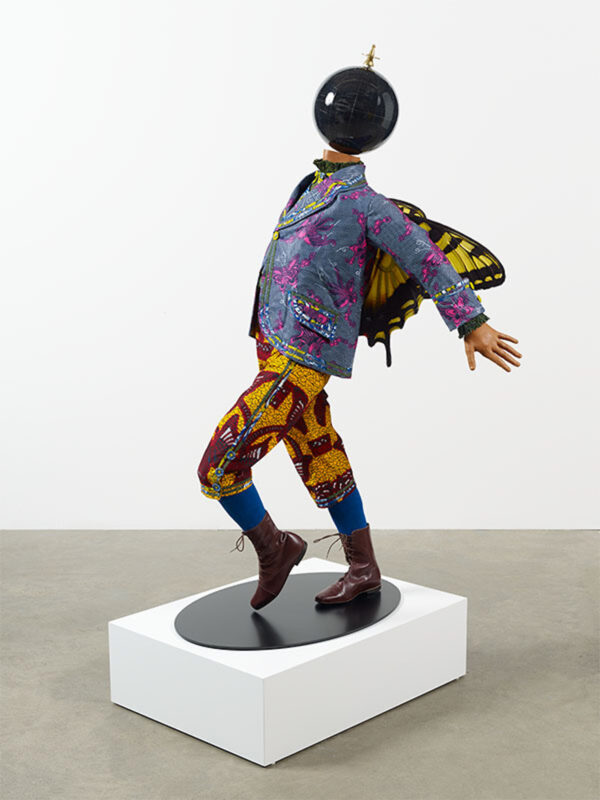
The Brooklyn Museum will present the first major survey of the work of the British-based, Nigerian artist Yinka Shonibare MBE, whose art explores the relationship of contemporary African identity to European colonialism. On view June 26 through September 20, 2009, Yinka Shonibare MBE will include more than twenty works, among them sculptures, paintings, large-scale installations,
and films.
The exhibition will be on view in the fourth-floor galleries in the Schapiro Wing and in the first-floor Blum gallery. There will also be a site specific installation created for this presentation featuring smal children and titled Mother and Father Worked Hard So I Can Play that will be on view in several of the Museum’s period rooms.
Shonibare is best known for working with visual symbols, especially the richly patterned Dutch wax fabric, produced in Europe for a West African market, which he uses in a wide range of applications. His tableaux of headless mannequins costumed in this fabric evoke themes of history and its legacy for future generations. Through these works he explores the complex web of interactions, both economic and racial, that reveal inequalities between the dominant and colonized cultures of Europe, Asia, and Africa.
The exhibition is organized by The Museum of Contemporary Art in Sydney, Australia. Judy Kim, Brooklyn Museum Curator of Exhibitions and Head of the Exhibitions Division, will coordinate the presentation, after which it will travel to the National Museum of African Art, Smithsonian Institution, Washington, D. C.
Shonibare was born in 1962 in the United Kingdom to Nigerian parents, who returned to Lagos with their children when he was three. When he was seventeen he relocated to London, where he currently lives and works.
He studied at Goldsmiths College, University of London, and at the Byam Shaw School of Art, Central Saint Martins College of Art and Design, University of the Arts, London. His work has been presented in solo and group exhibitions and is in public and private collections throughout the world. In 2005 Shonibare was awarded a Member of the Order of the British Empire, MBE, a distinction he uses despite and because of its irony.
While in art school Shonibare was asked why his work was not African in theme, a question that eventually led him to address issues of stereotypes and authenticity in his work. He selected the Dutch wax fabrics for use in multiple applications because they had become a signifier of authentic African identity while evoking a sense of ambiguity and complex origins; he opted to purchase them in London rather than Africa to render the material’s connotations of African exoticism false.
Citing feminist theory and deconstructionist literature as influences on his work, Shonibare explores the idea of the outsider masquerading within the dominant culture while remaining peripheral or external to it. Also influential are painters such as Thomas Gainsborough and Rococo artist Jean-Honoré Fragonard, who portrayed the eighteenth-century culture of excess. Shonibare’s sculpture installation The Swing (2001), which responds to Fragonard’s 1767 painting of the same name, depicting a privileged young woman at leisure, will be included in the exhibition.
In the site specific installation Mother and Father Work Hard so I Can Play, Shonibare will draw upon what he views as the expressions of American middle-class aspiration and achievement exemplified in the Museum’s period rooms to create a sort of treasure hunt. Headless figures of mischievous children whose presence will not be immediately apparent will be seen playing in unexpected and physically challenging positions. The figures, exemplifying privileged youth, will be clad in Victorian costume made from African fabrics.
Also on view will be Scramble for Africa (2003), in which the artist draws upon the moment in nineteenth-century expansionism when leading world powers carved up the continent of Africa at the Berlin Conference of 1884-85. Various statesmen, typically headless, are huddled around a table using a large map of Africa to stake their claims. Also on view will be Black Gold II, one of a series of paintings that explores themes of colonial domination and exploitation, in which multi-national companies extract Africa’s natural resources while its indigenous people live in poverty.
Shonibare continues his exploration of themes of wealth, class, and privilege with The Victorian Philanthropists’ Parlour (1996-97), the artist’s version of an opulent nineteenth-century interior, replete with furniture upholstered with Dutch wax fabrics and designed like a stage set in which visitors will be able to walk around. Also on view will be Diary of a Victorian Dandy, a suite of five large-scale photographs showing the dandy’s activities throughout the course of a day and featuring Shonibare and a supporting cast in Victorian costume.
The exhibition will include two recent films, among them Un Ballo in Maschera (2004), which takes its title from the Verdi opera (2004), inspired by the assassination of Swedish King Gustav III at a masked ball in Stockholm. An ambitious, technically complex project, the 32-minute costume drama features performers in Dutch-wax-fabric ball gowns, frock coats, and Venetian masks, and explores themes of frivolity and excess.









